|
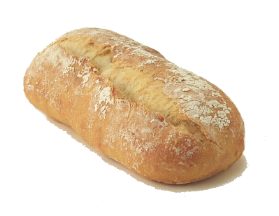 Bread Recipes! - The Italian Cook Bread Recipes! - The Italian Cook
Day or night for a quick and refreshing meal there is always fresh bread served in almost every meal in in any traditional italian meal.
Wow, creating bread. This is my favourite recipe page because bread is wonderful to make when you watch it rise in the oven and look at the expressions of everybodies face when the bread is served hot.
Almost every food retailer sells bread. You local baker has a variety of bread that will compliment any meal you serve.
The first breads produced were probably cooked versions of a grain-paste, made from ground cereal grains and water, and may have been developed by accidental cooking or deliberate experimentation with water and grain flour. Descendants of these early breads are still commonly made from various grains worldwide, with the Mexican tortilla, Indian chapati, Chinese poa ping, Scots oatcake, North American johnnycake, and Ethiopian injera all being examples.
The basic flat breads of this type also formed a staple in the diet of many early civilizations with the Sumerians eating a type of barley flat cake, and the 12th century BC Egyptians being able to purchase a flat bread called from stalls in the village streets.
If you have a great bread recipe, please share with us. If you have questions regarding this recipe page, please fill out our online contact form and it will be our pleasure to respond.
Bread Recipe List |
|
Bread Baking Tips and Solutions
|
|
| |
Basic Garlic Bread
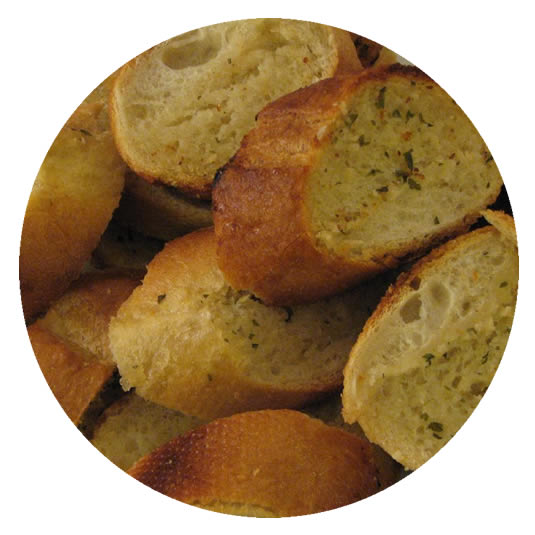 Ingredients: Ingredients:
• 1 loaf of French Bread, 18to 24 inches long
• 8 cloves of fresh garlic, peeled and put through a garlic press
• 1/2 cup St. Dalfour Marinade
• 1/2 cup grated Parmigiano Reggiano
Directions:
1• Preheat oven to 350 degrees F.
2• Cut French Bread into 4 equal sections, then slice each section in half lenghthwise.
3• Mix garlic and Marinade together in a bowl.
4• Liberally brush Marinade mixture over each of the eight pieces of bread.
5• Sprinkle with Parmigiano Reggiano
6• Bake in oven for 15 minutes, remove and serve immediately.
7• This also makes a great finger food when cut into bite sized pieces.
Serves 4
|
|
| |
Italian Bread Recipe
 Ingredients: Ingredients:
1.5 teaspoons active dry yeast
2 tablespoons crisco or tenderflake
1 1/4 cups warm water
2.5 tablespoons white sugar
2 teaspoons salt (neutral salty taste0
3 cups all-purpose flour
1.5 tablespoon butter, melted
Directions:
1• Mix together shortening, sugar, salt, yeast, and 1 cup flour. Add warm water and beat by hand until manageable, or 3 minutes with an electric mixer. Add remaining flour, scraping bowl often, and mix all together until smooth.
2• Cover with a clean cloth and let rise until doubled in volume.
3• Stir dough down gently, and spoon into a lightly greased 9x5 inch loaf pan (the batter should be sticky). Pat down with floured hands to help shape. Cover again, and let rise for about 30 minutes.
4• Preheat oven to 375 degrees F (190 degrees C).
5• Bake for about 45 minutes. Place on a cooling rack, and brush top with melted butter.
|
|
| |
White Bread Recipe
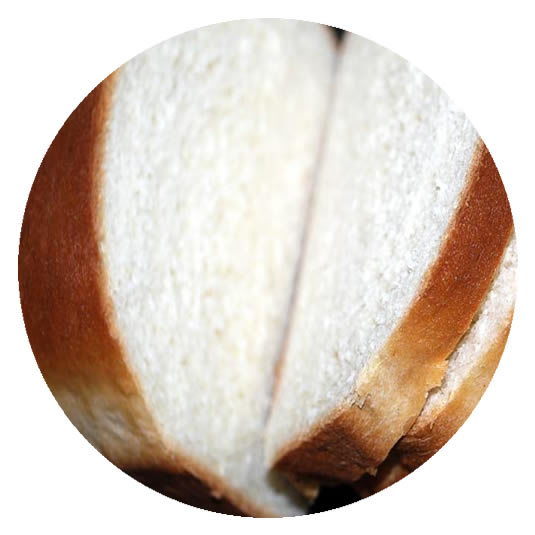 Ingredients: Ingredients:
1 tsp (5 mL) sugar
1/2 cup (125 mL) water, warm
1 envelope (8 g) active dry yeast (2 1/4 tsp/11 mL)
1 1/2 cup (250 mL) milk
2 tbsp (30 mL) butter or margarine
1 1/3 tsp (7 mL) salt
1/2 cup (125 mL) water, warm
5 cups (1375 mL) White Flour
Directions:
1• Add 1 teaspoon (5 mL) sugar in 1/2 cup (125 mL) warm water in large bowl. Sprinkle in yeast. Let stand 10 minutes, then stir well.
2• Heat 1 1/2 cup (250 mL) milk to lukewarm. Stir in butter, 2 tablespoons (30 mL) sugar, salt and 1/2 cup (125 mL) warm water. Add milk mixture and 2 cups (500 mL) White Flour to dissolved yeast mixture. Mix until smooth and rubbery.
3• Stir in 2 1/2 cups (625 mL) of remaining flour gradually. If necessary, add more flour to make a soft dough which leaves sides of bowl. Turn out on floured board. Round up into a ball.
4• Knead dough, adding more flour as necessary, until dough is smooth, rubbery and no longer sticky (about 10 minutes).
5• Place in lightly greased bowl. Turn dough to greased top. Cover with greased waxed paper and tea towel.
7• Let rise in warm place (72°-82°F/23°-28°C) until doubled (usually 45-60 minutes or longer if needed).
8• Punch down. Turn out onto lightly floured board and divide into 2 equal portions. Cover and let rest for 10 minutes.
9• Let rise in warm place until dough rises 1 1/2" (3 cm) above top of pan in centre and corners are filled (45 to 60 minutes).
10• Bake at 400°F (200°C) on lower oven rack for 25 to 30 minutes. Remove from pans immediately. Brush top crust with butter if a soft crust is desired. Let cool on wire racks.
11• This white bread recipe makes 2 loaves.
|
Casalinga Bread - Traditional Homemade White Bread
|
| |
Casalinga - Traditional Homemade White Bread
 Ingredients: Ingredients:
2 (.25 ounce) packages active dry yeast
2 cups warm water (110 degrees F/45 degrees C)
6 1/2 cups all-purpose flour
1 teaspoon salt
1/3 cup butter, chilled and diced
Directions:
1• In a small bowl, dissolve yeast in warm water. Let stand until creamy, about 10 minutes.
2• In a large bowl, combine 4 cups of flour and salt. Cut in the butter and stir in the yeast mixture. Beat in the remaining flour, 1/2 cup at a time. When the dough has pulled together, turn it out onto a lightly floured surface and knead until smooth and elastic, about 10 minutes. Butter a large bowl, place the dough in the bowl, and turn to coat. Cover with a damp cloth and let rise in a warm place until doubled in volume, about 1 hour.
3• Preheat oven to 400 degrees F (200 degrees C). Lightly grease a large baking sheet.
4• Deflate the dough and turn it out onto a lightly floured surface. Form the dough into a large oval loaf. Place onto the prepared pan. Cover with a damp cloth and let rise until doubled in volume, about 30 minutes. When the loaf is risen, cut a 1/2 inch deep cross onto the top of it. Brush the top with water before baking.
5• Bake in preheated oven for 25 minutes. Reduce heat to 350 degrees F (175 degrees C) and bake for an additional 15 minutes, or until bottom of loaf sounds hollow when tapped. Let cool on a wire rack before slicing.
|
|
| |
Ciabatta Bread Recipe
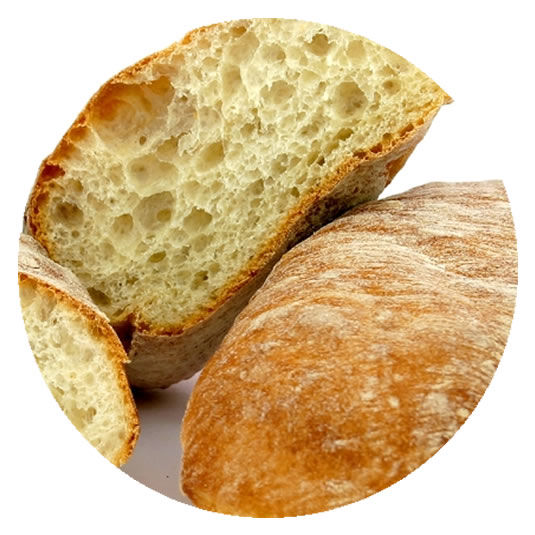 Ingredients: Ingredients:
12oz / 350g plain flour
1/4 teaspoon easy blend yeast
7fl oz/200ml warm water
olive oil
1/2 pint /300ml warm water
1 tablespoon olive oil
5 tablespoons warm milk
1 1/4 lb / 500g plain flour
1 teaspoon easy blend yeast
1 tablespoon salt
cornmeal to dust
Directions:
1 • Add yeast to sifted flour and slowly mix in the water. Beat for five minutes. Place in a bowl and brush with olive oil. Cover and leave to rise in a warm place until tripled in size (5-24 hours). Now chill.
2 • Stir the warm water, milk and olive oil into the chilled mixture. Slowly add this mixture to the 1 1/4 lb of flour, adding the yeast and salt.
3 • Using either a food processor or those at the end of your wrists, form into a dough and then knead on a floured surface until springy. Put dough in an oiled bowl, cover and leave to rise until doubled in size.
4 • Divide into four and stretch dough into rectangles, pressing flat with your knuckles. Cover with a damp cloth and leave in a warm place for 2 hours. Pre-heat oven to 220°C, gas mark 7. Heat baking sheets in oven. Dust baking sheets with cornmeal and place dough on top.
5 • Bake 25 minutes, sprinkling with water three times during the first 10 minutes.
|
|
| |
Cheese Herb Bread
 Ingredients: Ingredients:
2 cups warm water (110 degrees F/45 degrees C)
2 tablespoons margarine, softened
1 1/2 tablespoons dried oregano
2 tablespoons white sugar
4 1/2 teaspoons active dry yeast
1/2 cup grated Parmesan cheese
4 1/2 cups all-purpose flour
2 teaspoons salt
1 tablespoon grated Parmesan cheese
Directions:
1• Sprinkle yeast over water in large bowl. Let stand a few minutes, then stir and dissolve yeast. Add sugar, salt, margarine, 1/2 cup Parmesan cheese, oregano and 3 cups of the flour. Beat at slow speed for 2 minutes. Beat in rest of flour; cover the bowl with a sheet of wax paper and a kitchen towel. Let rise in a warm place 45 minutes, or until doubled in volume.
2• Preheat oven to 350 degrees F (175 degrees C). Lightly grease one round, 2-quart casserole. Set aside.
3• Stir batter down for 1/2 a minute. Turn batter into casserole. Sprinkle with the remaining 1 tablespoon Parmesan cheese.
4• Bake at 350 degrees F (175 degrees C) for 55 minutes. Makes one (1).
|
|
| |
Focaccia Bread Recipe
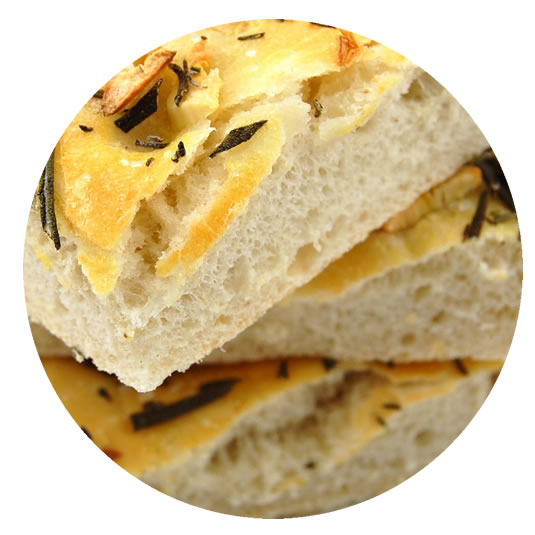 Ingredients: Ingredients:
2 3/4 cups all-purpose flour
1 teaspoon salt
1 teaspoon white sugar
1 tablespoon active dry yeast
1 teaspoon garlic powder
1 teaspoon dried oregano
1 teaspoon dried thyme
1/2 teaspoon dried basil
1 pinch ground black pepper
1 tablespoon vegetable oil
1 cup water
2 tablespoons olive oil
1 tablespoon grated Parmesan cheese
1 cup mozzarella
Directions:
1• In a large bowl, stir together the flour, salt, sugar, yeast, garlic powder, oregano, thyme, basil and black pepper. Mix in the vegetable oil and water.
2• When the dough has pulled together, turn it out onto a lightly floured surface, and knead until smooth and elastic. Lightly oil a large bowl, place the dough in the bowl, and turn to coat with oil. Cover with a damp cloth, and let rise in a warm place for 20 minutes.
3• Preheat oven to 450 degrees F (230 degrees C). Punch dough down; place on greased baking sheet. Pat into a 1/2 inch thick rectangle. Brush top with olive oil. Sprinkle with Parmesan cheese and mozzarella cheese.
4• Bake in preheated oven for 15 minutes, or until golden brown. Serve warm.
|
|
| |
Black Treacle Loaf Recipe
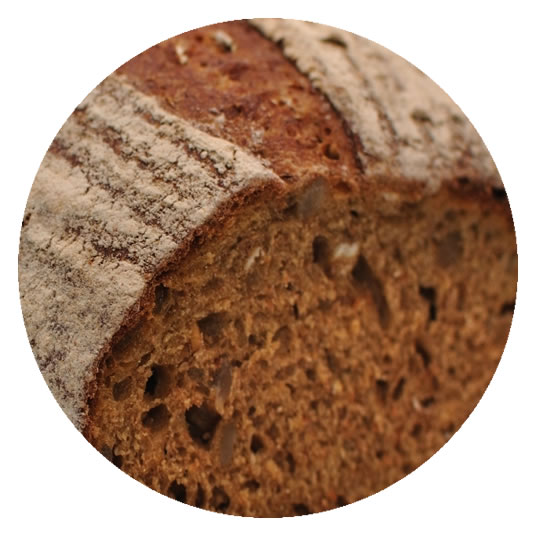 Ingredients: Ingredients:
1/4 cup black treacle
1/4 cup firmly packed brown sugar
1 egg
4 tablespoons butter
1/4 cup milk
1 1/4 cup flour
1/2 cup raisins, chopped
1 teaspoon baking soda
1/2 teaspoon ground cinnamon
1/2 teaspoon ground nutmeg
1/2 teaspoon ground cloves
1/2 teaspoon ground ginger
Directions:
1• Preheat oven to 350 degress. In a medium bowl, cream black treacle, brown sugar, and egg.
2• In a small sauce pan melt together butter and milk. Cool and stir into treacle mixture.
3• In a small bowl, combine flour, raisins, baking soda, and spices. Stir, all at once, into the treacle mixture, until just smooth.
4•Butter a small loaf pan (approximately 2 1/2 x 4-inch). Pour bread batter into loaf pan and bake in pre-heated oven for 30-35 minutes, until top is dry.
|
|
| |
Saint Joseph's Bread
 Ingredients: Ingredients:
• 3 cups unbleached all-purpose flour
• 1 1/2 teaspoons active dry yeast
• 1 tablespoon honey
• 2/3 cup hot water
• 1/2 teaspoon salt
• 2 tablespoons butter
• 3 tablespoons anise
• 1/3 cup golden raisins
• 1 tablespoon cornmeal
Directions:
1• In a large bowl, stir together 1 1/2 cups of the flour, yeast, honey, hot water, salt, butter and anise seeds. Mix into a smooth batter. Stir in the golden raisins, and beat for another 10 minutes, gradually adding flour until the dough pulls away from the sides of the bowl.
2• Turn the dough out onto a lightly floured surface. Knead for another 8 to 10 minutes, until the dough is smooth and elastic. You may not need to use all of the flour. Place the dough into a lightly oiled bowl, and turn to coat. Cover with plastic wrap, and place in a warm place until doubled in size, about 1 hour.
3• Grease a baking sheet and dust with cornmeal. Turn the dough out onto a lightly floured surface, and punch out all of the air. Roll into a long tight loaf, and place seam side down onto the prepared baking sheet. Use a sharp serrated knife to make 3 or four diagonal slashes on the top. Cover with a tea towel, and let rise until double in size, about 30 minutes.
4• Preheat the oven to 350 degrees F (175 degrees C). Mist the loaf with water of vinegar before baking, and twice during.
5• Bake for 35 to 40 minutes in the preheated oven, or until the crust is golden brown, and the loaf sounds hollow when tapped on the bottom.
|
Sun dried tomatoe and provolone bread
|
| |
Sun dried tomatoe and provolone bread
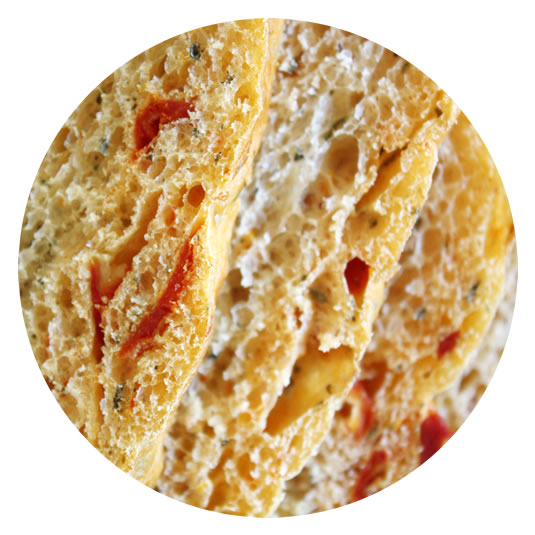 Ingredients: Ingredients:
2 1/2 cups all-purpose flour
2 teaspoons baking powder
1/2 teaspoon baking soda
1 teaspoon salt
1 cup shredded Provolone Piccante
1/2 cup thinly sliced scallion
2 tablespoons minced Italian parsley leaves
3/4 teaspoon dried rosemary, crumbled
3/4 teaspoon coarsely ground pepper
1/3 cup drained and chopped Il Forteto sun-dried tomatoes
2 tablespoons of the oil from the Il Forteto sun dried tomato jar
2 tablespoons vegetable shortening
2 tablespoons sugar
2 garlic cloves, pealed and minced, sauteed in 2 tablespoons of oil from Sun Dried Tomato jar
2 large eggs, beaten lightly
1 1/4 cups, buttermilk
1/3 cup pine nuts or walnuts, toasted lightly
Directions:
1• Into a large bowl sift together the flour, the baking powder, the salt, and the baking soda.
2• Add the provolone, the scallion, the parsley, the rosemary, the pepper, and the sun-dried tomatoes, and toss the mixture well.
3• In a small bowl whisk together the shortening, the sun-dried tomato oil, and the sugar until the mixture is smooth.
4• Add the garlic, the eggs, and the buttermilk, and blend mixture until it is combined well.
5• Add the buttermilk mixture to the flour mixture with the nuts and stir the batter until it is just combined.
6• Divide the batter among 3 well-buttered 6x3 inch loaf pans, smoothing the tops, and bake the loaves in the middle of a preheated 350F oven for 45 minutes, or until a tester comes out clean.
7• Let the loaves cool in the pans for 5 minutes, loosen the edges with a knife, and turn the loaves out onto a rack.
Makes 3 loaves.
|
| |
Bread Baking Tips and Solutions |
| |
|
| |
- Browning on sides
a) Bright pans reflect heat away from sides so choose dark pans.
b) Do not overcrowd the oven. This may restrict the volume in the oven and distribute the heat poorly and non efficiantly.
- Collapses in oven
a) To prevent over-rising when making yeast bread, the kneaded dough has to set in a slightly warm place in order to let the yeast act and the dough develop. This step improves the flavor and the texture of the bread.
-
To rise, place the kneaded dough in a lightly oiled, large mixing bowl. The dough should be turned over to oil the top so that it does not dry out. Cover the bowl loosely with plastic wrap or foil and let the dough rise in a warm, draft-free location. The oven is an ideal place for this. For an electric oven or a gas oven with electronic ignition, heat the oven at the lowest setting for one minute, then turn off. In other gas ovens, the pilot light will provide enough warmth. Place a pan of very warm water toward the back of the oven to provide moisture. Place the bowl or pan of dough on the center rack and close the door.
Many factors, including the recipe, room temperature, and humidity, will determine how long it takes for the dough to rise. The best way to decide whether it has risen sufficiently and is ready to be punched down and shaped is to perform a "ripe test." Gently stick two fingers in the risen dough up to the second knuckle and take them out. If the indentations remain, the dough is ripe and ready for punch down. If not, cover and let rise longer.
-
Cracking on tops
a) Do not cool bread in a draft.
b) Decrease flour amount
c) Increase kneading time to develop the gluten better.
- Crumbles easily
a) Increase the mixing time.
b) Decrease the flour amount.
c) Make sure the rising place is not over 90 degrees F.
d) Use the over-rising technique to prevent over-rising.
e) Use a higher oven temperature.
- Damp inside
a) Use an instant-read thermometer to be certain the bread is completely baked.
b) Use the over-rising technique to be sure dough has risen enough before baking.
- Dark lines in bread
a) Increase the mixing and kneading times.
b) Use less oil to grease rising bowl.
c) Be sure dough is covered during rising time.
- Doesn't rise in oven
a) Make sure the rising place is not over 90 degrees F
b) Use the ripe test to prevent over-rising.
- Doughy on bottom
a) Immediately after baking, remove from pans and cool on racks.
- Dough doesn't rise
a) Use thermometer for accurate liquid temperature.
b) Decrease the flour amount.
c) Use oven for a rising place.
d) Check activity of yeast.
- Dry and coarse grain
a) Decrease amount of flour.
b) Increase kneading time to develop the gluten better.
c) Use the over-rising technique to prevent over-rising.
d) Use a higher oven temperature.
- Heavy and compact
a) Decrease flour amount.
b) Use the over-rising technique to be sure dough has risen enough before baking.
c)Certain flours, such as whole wheat and rye, create heavier products than white flour.
- Holes in bread
a) Completely press air out of dough before shaping.
b) Use the over-rising technique to prevent over-rising.
- Sour taste
a) Make sure the rising place is not over 90 degrees F.
b) Use the over-rising technique to prevent over-rising.
- Thick crust
a) Decrease the flour amount.
b) Lengthen the rising time using the over-rising technique.
c) Use a higher oven temperature.
- Yeasty and smelly
a) Use the over-rising technique to prevent over-rising.
b) Make sure the rising place is not over 90 degrees F.
|
Home | Advertising Information | Contact Us
Copyright ©2002 Italian Recipes Trinakria Development. All rights
reserved.
|
 |
|
 |


 Ingredients:
Ingredients: Ingredients:
Ingredients: Ingredients:
Ingredients: Ingredients:
Ingredients: Ingredients:
Ingredients: Ingredients:
Ingredients: Ingredients:
Ingredients: Ingredients:
Ingredients: Ingredients:
Ingredients: Ingredients:
Ingredients: